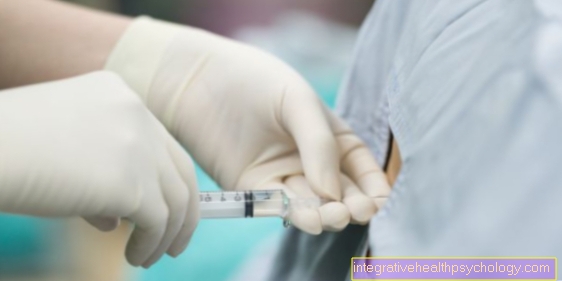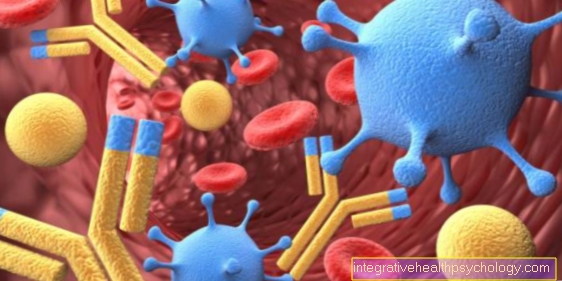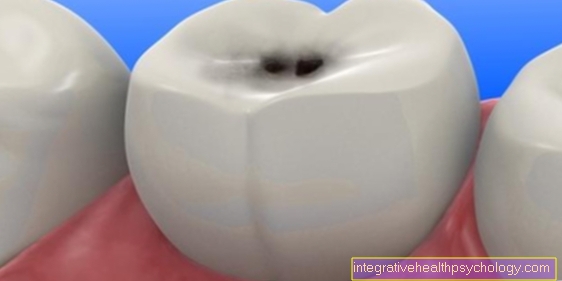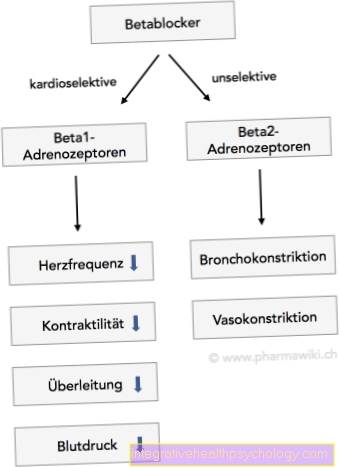Paget's disease
General
A malignant degeneration of the female breast tissue (lat. "Mom") designated. In western countries in particular, breast cancer is the most common type of cancer and, statistically speaking, every ninth woman will develop cancer in the course of her life. The peak of the disease is around 45 years of age and the risk increases again after the menopause.
In proliferating breast cancer, two forms can be distinguished depending on where it occurs:
- lobular carcinoma, which is localized on the glandular lobules of breast tissue, and
- ductal carcinoma, which is found in the gland ducts of the breast.

Other forms of breast cancer are also known, but they occur much less frequently. This includes the inflammatory (inflammatory) Breast cancer, which is also the most dangerous form. The so-called "Carcinoma in situ"Is not growing invasively yet (tissue-destroying) and therefore has a better prognosis, but a development into an invasively growing breast cancer is possible. Paget's disease of the mammary gland is a form of breast cancer that initially manifests itself mainly as eczema in the area of the nipple. This eczema is very itchy.
While already 1856 the changes to the nipple were described by Paget's disease, these changes only became apparent 1874 by J.Paget with the Breast cancer (Breast cancer) connected. J. Paget conducted a study on 15 patients who he observed had similar nipple injuries and all of them developed breast cancer a few years later.
In the years that followed, many more studies and attempts were made to address the Pathomechanism (Disease course / development) to find out.
The most important study on this, however, then led Jacobeus 1904 who identified Paget's disease as an interductual cancer. At the time, however, there was still the opinion that this cancer was precancerous, cancer of the apocrine glands or chronic degenerative Change in skin be.
Epidemiology
It settles in or around the nipple. Paget's cancer is 0.5 to 5% of all breast tissue changes.
Most of the affected patients are between 40 and 50 years old, but Paget's disease can rarely manifest itself in patients aged 20 or over. The average age for the first illness with Paget's disease is currently 62 years for women and 69 years for men.
Paget's disease of the nipple
Paget's disease of the nipple is a rare cancer that can affect other parts of the body. Almost only women develop this cancer, which often goes undetected for a long time. In the early stages, the cancer resembles eczema of the nipple and is therefore often mistakenly treated with ointments and creams. Unlike other cancers, it is neither palpable as a lump, nor does it show other symptoms that would initially suggest cancer. Itching, reddening of the skin and eczematous, scaly skin changes on the nipple are the first symptoms of Paget's disease.
If there is no improvement through dermatological treatments, however, there is usually a suspicion of Paget's disease. Bloody secretions later develop and the affected nipple is retracted. The diagnosis can be confirmed by taking a sample. Large, rounded cells with altered cell nuclei can then be seen under the microscope.
The treatment of choice is surgical removal of the cancer, while preserving the breast if possible. If the lymph nodes are involved, the affected lymph nodes must also be removed. After the operation, the tissue is irradiated to prevent a relapse. In advanced stages, these therapy options are insufficient and chemotherapeutic therapy approaches must be considered. Paget's disease is treated individually depending on the nature of the tumor, the degree of metastasis and the individual requirements of the person affected. A curative therapeutic approach is possible in the early stages of the disease.
Unusual skin rashes on the nipple, indentations or bloody secretions should therefore always make you suspicious and lead to a visit to the gynecologist.
trigger
To date, the exact development of the type of cancer "Paget's disease" has not been determined, but two theories have been developed.
The one theory currently considered the most likely is that the cancer cells (called Paget cells) form a tumor in the breast, which then penetrates the surface and causes visible skin changes on the nipple. According to this theory, 97% of patients with Paget's disease already have breast cancer or a similar cell change in the breast where abnormal cells have made their way through the ducts of the breast to the nipple. In further development, according to this theory, the cancer then spreads into the lymphatic vessels and then into other parts of the body.
The other theory is that the cells of the nipple spontaneously turned into Paget cells.
Pathogenesis
According to the latest scientific knowledge, Paget's disease of the nipple is an adenocarcinoma, which is caused by the continuous spread of a cancer in the breast (breast cancer).
The tumor cells of the adenocarcinoma of the breast (breast) spread continuously and grow into the nipple (nipple) and the surrounding skin (epidermotropic adenocarcinoma).
Symptoms
What is noticeable is a sharply demarcated, reddened, slightly scaly inflammatory focus that originates from the nipple. This focus gradually enlarges and becomes itchy or painful. An eczema-like appearance develops and a tumor nodule can often be felt behind the nipple.
Diagnosis
As soon as a unilateral eczema-like skin change in the area of the nipple and the areola is detected, this skin change should be examined histopathologically (microscopically).

- Nipple -
Papilla mammaria - Areola -
Areola mammae - Milk duct -
Lactiferous duct - Lobule of the mammary gland -
Lobuli glandulae mammariae - Adipose tissue -
Corpus adiposum mammae - Ribs - Costas
- Pectoralis major -
Pectoralis major muscle - Anterior saw muscle -
M. serratus anterior - Outer weird
Abdominal muscles -
Obliquus muscle
externus abdominis - Chest wall - thorax
- Skin - Cutis
You can find an overview of all Dr-Gumpert images at: medical illustrations
Histopathology
A closer look at the tissue reveals that there is a diffuse penetration of the epidermis with Paget cells (strikingly large, clear PAS-positive epidermal cells with pale cytoplasm and large, mostly oval cell nuclei). The upper layer of the skin (dermis) contains a so-called lymphohistiocytic inflammatory infiltrate.
Differential diagnosis
Other possible causes of the skin changes on the nipple can include:
- Nipple eczema
- Contact eczema ("Allergy")
- psoriasis (Psoriasis)
- Scabies (mites)
- Bowen's disease
- superficial basal cell carcinoma
therapy
The prognosis and therapy of Paget's disease depend entirely on the stage and type of breast cancer. In the case of Paget's disease, treating only the skin changes is by no means sufficient and ineffective, as the cancer continues to grow in the breast tissue underneath.
Read more about the here Breast cancer stages and the Therapy for breast cancer.
Prognosis / chances of recovery
Paget's disease of the breast, also known as Paget's carcinoma, is a rare form of cancer that can affect other parts of the body and occurs almost exclusively in women. Often it is not properly diagnosed at first because its clinical appearance can easily be confused with eczema of the nipple. For the prognosis of Paget's disease, however, early detection is very important. In the early stages, surgery with subsequent tissue irradiation is usually sufficient to achieve healing. In addition, the lymph nodes in the armpit must be examined and removed if necessary. However, there are factors that can significantly worsen the prognosis for Paget's disease. The most important prognostic factor is the lymph node status. This describes the infestation of the lymph nodes by tumor cells. The greater the lymph node involvement, the worse the chances of recovery for those affected. Other factors, such as the grade of the tumor and the receptor status, as well as the general condition of the person affected and any previous illnesses, also play an important role in the prognosis of the individual case.




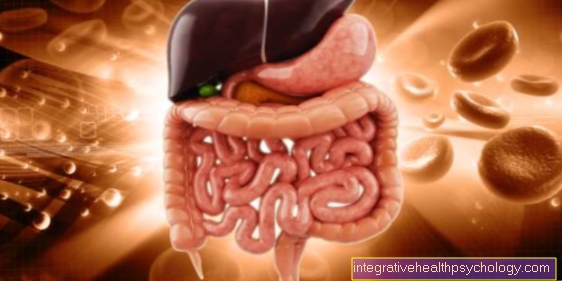





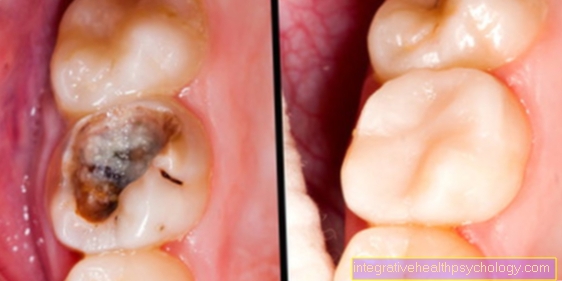



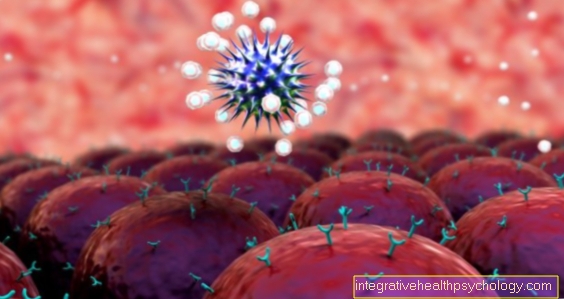
.jpg)





